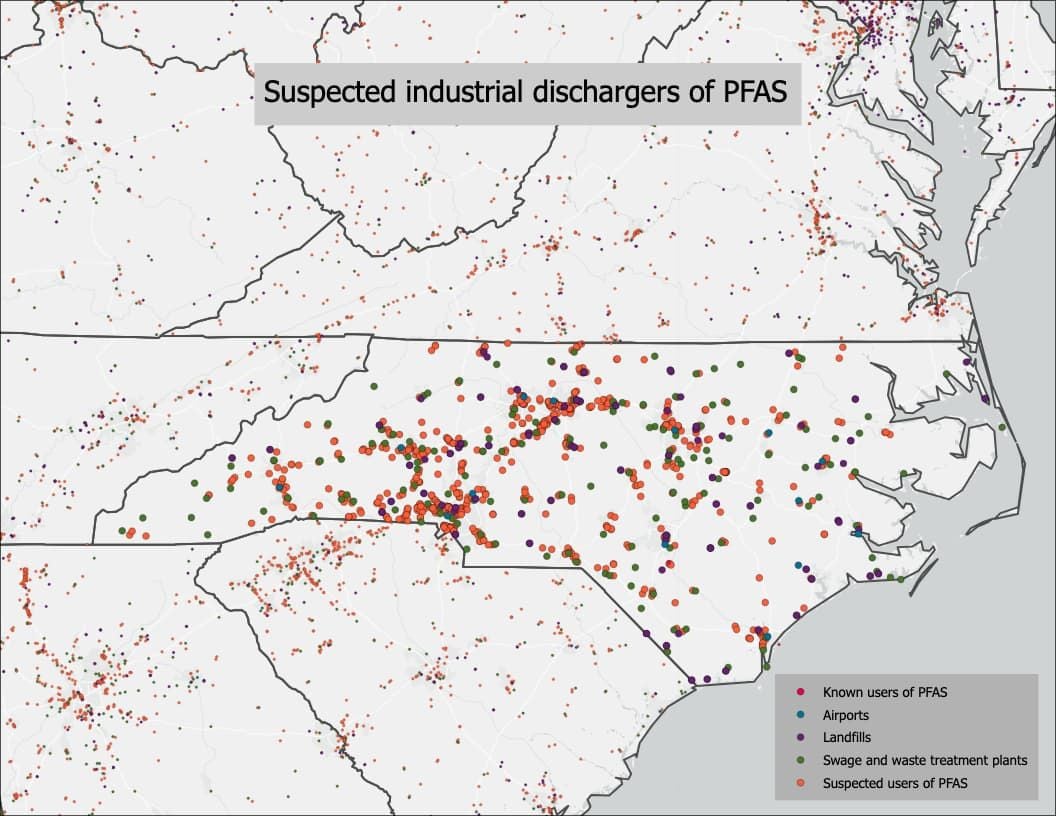
Drinking water for at least 2.5 million North Carolinians is contaminated with the toxic “forever chemicals” known as PFAS at levels exceeding new federal standards, according to an EWG analysis.
Across 49 drinking water systems, some far exceed the Environmental Protection Agency’s PFAS standards finalized in April. Levels of the forever chemicals PFOA and PFOS in a community in Fayetteville were more than double and triple the new federal limits, respectively. In many other parts of the state, levels top the amount of PFAS in water the agency allows.
The EPA’s standards limit six PFAS in drinking water and may bring much-needed relief from the PFAS contamination crisis in North Carolina and beyond, if water utilities take the steps needed to comply.
To meet the standards, systems must treat water to remove PFAS, and look for ways to turn off the tap on forever chemicals pollution. Only by complying fully with their duties under the EPA’s standards will the water utilities be able to provide millions in North Carolina with the safe drinking water they’ve long sought.
EWG’s analysis is based on averaged drinking water testing results from 2022 reported by North Carolina, and information from the EPA’s Fifth Unregulated Contaminant Monitoring Rule, also known as the UCMR 5.
What are PFAS?
PFAS are a group of thousands of highly toxic fluorinated chemicals used in numerous consumer and industrial products because of their nonstick and stain-resistance qualities.
Two of the most well-studied and notorious PFAS are PFOA, once used by DuPont to make Teflon, and PFOS, previously used in 3M’s Scotchgard. Because of health concerns, the two companies phased them out, under pressure from the EPA. The agency’s new drinking water limits will help remove lingering PFOA and PFOS from drinking water.
These and other PFAS don’t break down in the environment and they build up in the body. People can be exposed through drinking water and food polluted with forever chemicals and exposure to PFAS-laden dust shed by consumer products.
Contact with PFAS is linked to a number of serious health harms, including impaired immune system response, liver and kidney damage, hormone disruption, developmental and reproductive issues and several types of cancer.
Long-awaited limits
The EPA’s new standards will benefit North Carolina’s residents by targeting six notorious PFAS: PFOA, PFOS, PFNA, PFHxS, PFBS and GenX. The legal limits, known as maximum contaminant levels, or MCLs, are the highest level of a contaminant allowed in drinking water.
The agency set a limit of 4 parts per trillion, or ppt, for both PFOA and PFOS. The MCL for GenX, PFNA and PFHxS is 10 ppt. A hazard index calculated for the mixture of PFNA, PFHxS, PFBS and GenX was also introduced to account for combinations of chemicals in tap water.
Forty-seven community drinking water systems in the state had recent PFAS detections at levels above one or more of the MCLs, according to EWG’s analysis.
These levels of contamination will likely require those systems to take steps like changing water sources or installing filtration in order to remove PFAS from drinking water. Large water systems often use multiple water sources, and the EPA estimates that, on average, water systems with high PFAS levels will require corrective action at about half of the sites where the chemicals enter the system.
The regulations are a monumental victory for public health and environmental justice. But implementation – and the lower PFAS levels that will result – takes time: Water utilities have up to five years to comply. In the meantime, residents of communities with detections may need to consider in-home filtration.
Some of the largest utilities in the state are dealing with PFAS levels above the EPA’s new standards and will have to, or are currently, taking steps to address the contamination to provide clean drinking water.
Largest North Carolina water utilities with PFAS detections above EPA MCLs
Water utility | Population served | Average PFAS concentration* | Name and status of treatment plant |
Piedmont Triad Regional Water Authority | 367,681 | PFOA (5 ppt), PFOS (9ppt) | John Franklin Kime Water Treatment Plant Expansion and reverse osmosis treatment system proposed. |
City of Durham | 321,414
| PFOS (5 ppt) | No treatment system proposed at time of publication. |
City of Greensboro | 318,057 | PFOS (27ppt), PFHxS (12 ppt) | Mitchell Water Treatment Plant Granular-activated carbon filters underway and other proposed plant upgrades. |
Fayetteville Public Works Commission | 214,137
| PFOA (8ppt), PFOS (16 ppt) | Hoffer Water Treatment Facility on the Cape Fear River and Glenville Lake Water Treatment Facility Granular-activated carbon filtration system and plant upgrades underway. |
Brunswick County Public Utilities | 152,030 | PFOA (5 ppt), PFOS (9ppt) | Northwest Water Treatment Plant Ongoing upgrades and reverse osmosis treatment. system construction. |
*PFOA and PFOS limit of 4 ppt, PFHxS and GenX limit of 10 ppt
Source: EWG, EPA’s UCMR 5 testing, and 2022 tests by the state of North Carolina.
Other communities large and small across the Tar Heel State have struggled with PFAS contamination in their drinking water.
The Robeson County Water System, which serves 64,000 residents, found some of the highest levels of PFAS in the state during the UCMR 5 tests, including PFOS at 30 ppt and GenX at 33 ppt – both well above the new drinking water standards.
The Orange Water and Sewer Authority found 11 PFAS in one of its reservoirs. The utility serves more than 80,000 residents in the towns of Chapel Hill, home of the main University of North Carolina campus, Carrboro and parts of Orange County. It began monitoring PFAS levels in 2018. Upgrades to its treatment system to reduce PFAS in finished drinking water began in 2023.
Near Wilmington, high levels of contamination in the source water of the Cape Fear Public Utility Authority come from upstream industrial sources. The utility serves more than 200,000 residents. The system constructed extensive filtration technologies and as a result its water already complies with the new federal limits.
Communities suffering PFAS pollution
As a result of regional manufacturing operations, other industrial uses and discharges of forever chemicals into the air and water, North Carolina has been an epicenter of PFAS contamination in the U.S.
Lower Cape Fear region
With decades of exposure to industrial sources of forever chemicals, the bodies of Lower Cape Fear region residents are polluted by PFAS at two times the levels of the general U.S. population, according to a North Carolina State University study. The specific chemicals included PFOS, PFOA, PFNA and PFHxS. Residents are also overburdened with additional PFAS in their bodies from one specific industrial polluter.
Fayetteville Works, a manufacturer once owned by DuPont, now Chemours, discharged PFAS into the Cape Fear River beginning in 1980. PFOA was detected in surface waters in 2007. But soon after DuPont stopped using PFOA for Teflon, it replaced that chemical with GenX – a new PFAS suspected of being every bit as toxic.
Residents were outraged again when the story broke that GenX was also found in Wilmington’s drinking water, in 2017. Samples from several years earlier revealed that newer PFAS alternatives were present in the source water at extremely high levels – over 100,000 ppt. GenX and other PFAS contamination of rainwater as well as seafoam along Brunswick County beaches has also been traced back to the Chemours plant.
Industrial facilities in many other of the state’s communities have also been polluting their drinking water supplies for years.
Pittsboro and Burlington
The downstream town of Pittsboro, which sources its drinking water from the Haw River, found extensive contamination in its tap water. The small community is home to a diverse population with no known industrial sources of PFAS. Nonetheless, because of upstream manufacturing, it faces high levels of exposure and added filtration costs.
Further, a study by scientists at Duke University found elevated levels of PFAS in the blood of Pittsboro residents at two to four times that of the general population.
In upstream Burlington, high levels of PFAS were detected in the city’s drinking water as well as wastewater entering the Haw River, likely due to industrial pollution. As a result of pressure and lawsuits from local activists, the city worked to identify upstream industrial sources of contamination.
Elevate Textiles was found to be a significant contributor to the PFAS in the city’s drinking water and waste water supply. The company used PFAS in their manufacturing and was allowed to discharge unlimited amounts in their wastewater.
As part of a recent settlement, the company will no longer discharge PFAS waste into the city’s wastewater treatment plant. It also plans to phase out production uses of PFAS.
As concerns about contamination began to mount, EPA tests conducted between 2013 and 2015 for the third UCMR for just six PFAS – PFOS, PFOA, PFNA, PFHxS, PFHpA, PFBS – found detections in only 20 drinking water systems in North Carolina. But due to high reporting limits, those tests likely missed systems with levels of PFAS that would now require filtration under the new EPA drinking water standards.
For example, at the time, results for PFOS were recorded for levels above 40 ppt only, or 10 times the new legal limit. Results below that limit were not reported.
According to another EWG analysis, there are at least 66 electroplating facilities and 50 chemical manufacturers in the state that could be sources of PFAS. In total, the state is home to 736 suspected industrial PFAS dischargers.
Sources of contamination in North Carolina are not limited to just a few facilities. Firefighting foam used near military facilities and airports, along with spreading wastewater sludge and textile manufacturing, may also be sources of pollution.

Source: EWG, Suspected industrial discharges of PFAS, EPA ECHO database
Military base contamination
Echoing a problem found in states across the U.S., military bases in North Carolina continue to face elevated PFAS levels linked to drinking water contamination and other exposures, both on base and in surrounding communities.
The drinking water at Marine Corps Base Camp Lejeune has been found to be highly contaminated with many cancer-causing chemicals, including trichloroethylene and benzene, as well as PFAS. A study by the Centers for Disease Control and Prevention and the Agency for Toxic Substances and Disease Registry found a higher risk of more than half a dozen types of cancer among service members and civilians who spent time at the base.
Department of Defense installations are a source of PFAS contamination in the state largely because of firefighting foams. Ten installations have confirmed PFAS in either drinking water, groundwater or both and are in the early stages of cleanup.
At least one of these sites, Seymour Johnson Air Force Base, is confirmed to have contaminated private drinking water wells off base at levels above the new EPA MCLs. And on-base communities at Fort Liberty, formerly known as Fort Bragg, have levels of PFAS in their drinking water above the new federal standards.
Consequences of inaction
A study of patients in the University of North Carolina Healthcare System found associations of PFAS exposure and increased risk of chronic disease such as high cholesterol, high blood pressure and heart disease, likely tied to industrial PFAS pollution in drinking water.
The PFAS contamination crisis in North Carolina is affecting not only people but also animals and wildlife, which suffer health harms when exposed to forever chemicals.
A study by researchers at North Carolina State University found elevated levels of PFAS in horses and dogs living in Gray’s Creek, near the Chemours Fayetteville Works facility. Levels of PFAS in dogs in Wilmington were similar to those of children living in the area.
Another study found PFAS exposure hurt the immune systems of alligators living in the Cape Fear River watershed, so that their wounds healed much more slowly.
Using novel analytical methods, researchers at the University of North Carolina and North Carolina State University in 2023 identified 11 new PFAS in the water downstream of the Chemours plant. The PFAS had not been previously identified.
These findings supported long-running calls by EWG and others to regulate these contaminants in drinking water, since methods used in meeting compliance with the new MCL for the six PFAS will likely lower other PFAS too. Groups such as Clean Cape Fear organized communities to hold polluters accountable for the exposure of millions of residents to the widespread PFAS contamination.
While waiting for the new federal drinking water limits on PFAS, residents of North Carolina advocated for safer drinking water, and took steps to protect their families through in-home filtration methods that capture PFAS.
To find the best way to reduce PFAS in homes, researchers at Duke and North Carolina State University also studied the effectiveness of in-home drinking water filters. Multistage carbon filters and reverse osmosis filters are most effective at lowering PFAS in homes, according to the research.
Another study by EWG also found that certain types of carbon-based pitcher filters are effective at reducing PFAS in tap water.
How the EPA MCLs will help
North Carolina state officials have worked with utilities to conduct voluntary monitoring of drinking water systems.
With the new federal drinking water limits for six PFAS, utilities can finally begin to take long-needed corrective action to address the issue of contamination and exposure from drinking water, not only in North Carolina but also across the U.S.
Before the Biden administration announced the new federal MCLs, some utilities started addressing PFAS contamination in their drinking water.
The Town of Maysville, serving a community of 1,000 people, and the Cape Fear Public Utility Authority, a large utility, resolved the contamination issues. They used available tools and resources to address the problem, and show how the new federal standards can be implemented state-wide.
Maysville paid for the new treatment with state and federal funding from the Biden administration’s 2021 Bipartisan Infrastructure Law. The Cape Fear Public Utility Authority has filed several lawsuits to recover the treatment costs.
Treatment to remove PFAS to meet the finalized MCLs will likely also lower the levels of other co-contaminants in drinking water. The treatment technology will also remove disinfection byproducts from drinking water, which the EPA estimates will prevent 1,844 bladder cancer deaths in the coming years. Additional EWG analysis supports the reduction of disinfection byproducts to reduce cancer risk. Added PFAS treatment may also remove other contaminants, such as volatile organic compounds.
Homes using private drinking water wells are not covered by the new drinking water standards. Residents with private wells in areas with suspected PFAS contamination should get their wells tested. The Bipartisan Infrastructure Law provides $1 billion to help well owners test for and address PFAS contamination.
The EPA’s finalized standards will improve water quality so that millions of people in the U.S., including those in areas that have been heavily affected by PFAS contamination, can finally have safer drinking water. Communities have shouldered the burden of PFAS pollution for far too long.
Other steps residents can take now on PFAS include:
- Learning about what’s in their drinking water from EWG’s interactive map showing systems with PFAS contamination.
- Using EWG’s Tap Water Database to find out more about contaminants in drinking water.
- Buying an in-home reverse osmosis or granular-activated carbon filter to reduce PFAS in drinking water.





